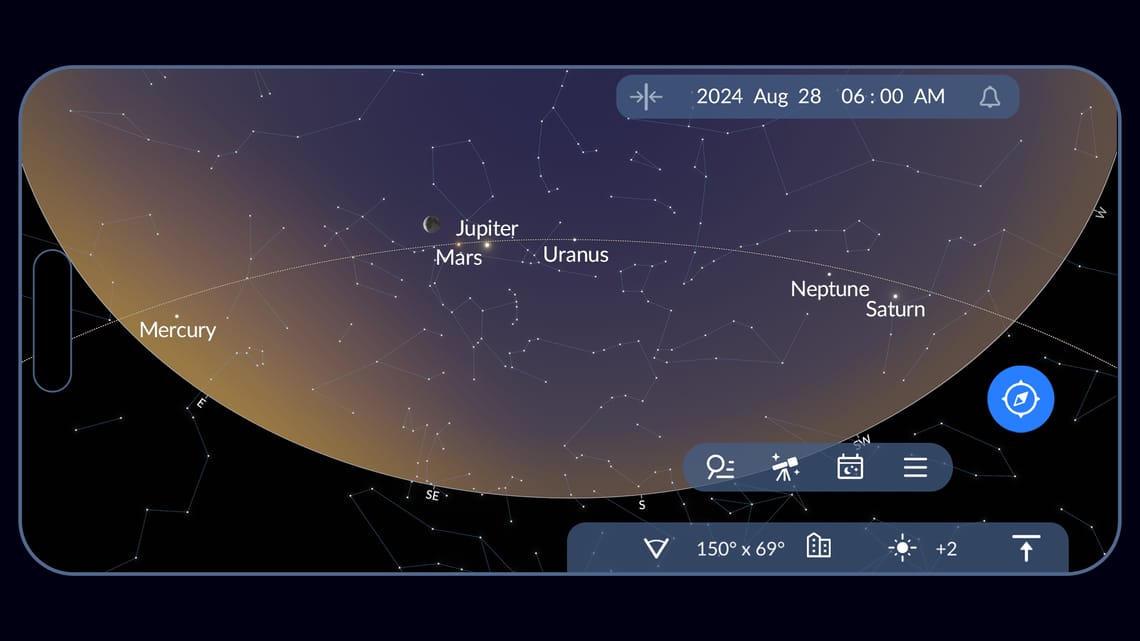Mercury, Mars, Jupiter, Saturn, Uranus and Neptune line up in the sky. They will be best visible on August 28. However, you will need a small telescope to see some of these planets.

Parade of planets on August 28
On August 28, you can see a parade or rather the lining up of six planets in the sky. In general, it should be noted that the “parade of planets” has a rather vague wording and situations that fall under its definition arise almost monthly.
“Alignment” of the planets is a narrower term, meaning a situation where they appear in the sky as a single line and can all be seen in the sky at the same time. This situation will occur on August 28. From three to seven celestial bodies can take part in the parades of planets, sometimes joined by the Moon and Pluto as well.
It is clear that the more planets participate in the parade of planets, the rarer this situation is. This time there will be 6 of them: Mercury, Mars, Jupiter, Saturn, Uranus and Neptune. They will also be joined by the Moon. So the situation will clearly be rare and worth paying attention to.
What can be seen on the night of August 28-29
Saturn will be the first to appear in the evening sky on August 28. Neptune will appear almost immediately next to it in the constellation Pisces. However, this planet will be visible only through a small telescope.
Saturn and Neptune will rise gently above the horizon, moving immediately southward. Uranus will also appear above the eastern horizon near the Pleiades cluster in the constellation Taurus. However, it will be clearly visible only through binoculars or a telescope.
At midnight, Jupiter will join the parade of planets. It will be in the same constellation Taurus and, unlike the previous two planets, it will be clearly visible to the naked eye. Later, Mars will also appear very close to the largest planet in the Solar System over the horizon.
At about 1 a.m., the Moon will appear above the horizon. However, it will be visible only as a narrow sickle. Finally, Mercury will appear in the morning twilight. Saturn and Neptune will already be leaning toward the western horizon at this time.
When can we see the next parade of planets
Alignments of 3 or 4 planets happen regularly. But 5 or more planets occur truly infrequently. The next time it happens will be January 18, 2025. Then 6 planets will line up in the sky: Mars, Jupiter, Uranus, Neptune, Saturn and Venus. And on February 28 of the same year, all seven major planets that can be seen from Earth will be visible in the sky.
There will also be several outstanding “parades” in future years. On September 8, 2040, the 5 planets that are visible to the naked eye (Mercury, Venus, Mars, Jupiter and Saturn) will line up in a narrow region of the sky and next to them will be the Moon, which will be clearly visible this time.
On March 15, 2080, six planets — Venus, Mercury, Jupiter, Saturn, Mars and Uranus — can be seen in the morning sky. This alignment is particularly notable because it will characterize the “grand conjunction” of Saturn and Jupiter, with only 6 angular minutes between them.
On May 19, 2161, all the planets of the Solar System, including Earth, will come together on the same side of the Sun. The alignment of the planets can be seen before dawn.
On November 7, 2176, all the planets of the Solar System, including Earth, will come together on the same side of the Sun. The alignment of the planets will be visible in the Earth’s sky immediately after sunset.
According to starwalk.space


